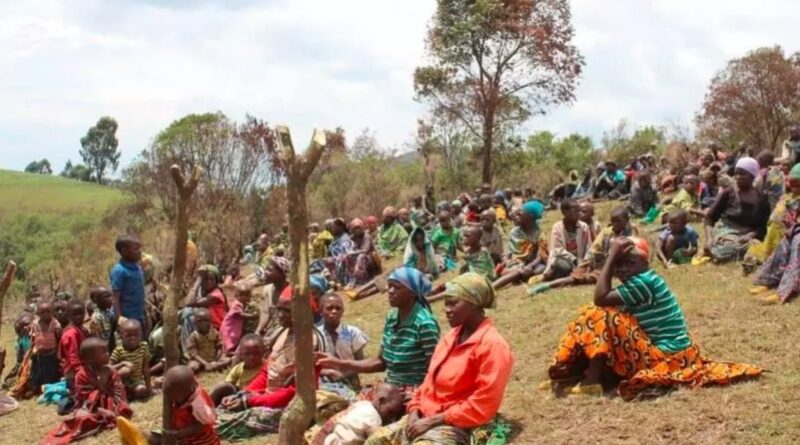Congo-Kinshasa: Civilians Caught in Crossfire In The Kivus
Goma has gradually been surrounded by several front lines, with between 600,000 and 1 million people displaced being crammed alongside the city’s two million residents.
Civilians are caught in the crossfire between the different armed groups; and are wounded, killed, or become victims of crime and, in particular, of sexual violence.
Heavy artillery fire in the camps around Goma has caused 23 deaths and 52 injuries since February 2024.
What is the situation?
Over the past two years, we have seen regular movements of people fleeing the fighting in North Kivu province and, more recently, in South Kivu. The many displaced individuals and families have mostly sought refuge in rudimentary camps on the outskirts of Goma, the capital of North Kivu.
In recent weeks, Goma has gradually been surrounded by several front lines, with between 600,000 and 1 million people displaced being crammed alongside the city’s two million residents. The concentration of armed men in and around the densely populated camps and the growing proximity of military positions to the displaced people has led to a general increase in the level of violence: civilians are caught in the crossfire between the different armed groups; and are wounded, killed, or become victims of crime and, in particular, of sexual violence.
In Goma, the displaced now find themselves in a similar situation to the one they had initially fled. They are in complete insecurity and have no way out. The camps for displaced persons must be respected by all parties to the conflict and fighting in the vicinity must stop.
This insecurity is compounded by extremely precarious living conditions. Displaced people are living in densely populated camps, in deplorable sanitary conditions without adequate access to water and sanitation services, in shelters made of plastic sheeting, on uneven ground made of volcanic rock. Access to drinking water and food is very difficult and unpredictable.
What is the impact of this violence on civilians?
According to our observations, heavy artillery fire in the camps around Goma has caused 23 deaths and 52 injuries since February 2024. According to the United Nations, at least 18 civilians, most of them women and children, died and 32 others were wounded in bombardments affecting several internally displaced persons (IDP) sites on the morning of May 3rd, alone.
Since the beginning of the year, we have observed crossfire and grenade explosions inside the camps, both day and night. We have recorded 24 incidents involving shellfire in or around the camps where we work, and MSF teams have received 101 non-life-threatening casualties, 70% of them civilians, at the Kyeshero hospital, transferred by the International Committee of the Red Cross (ICRC), which treats the most serious weapon-wounded patients. We are also concerned that patients delay seeking care in fear of the associated security risks.
In the Shabindu, Rusayo and Elohim camps, we treated more than 1,700 new cases of sexual violence in April, 70% of which were perpetrated by weapons carriers. MSF is able to provide medical and psychological care to survivors, but there are very limited referral options for legal support, safe shelters and other protection services. While the majority of survivors of sexual
violence treated by our teams report having been raped while collecting firewood, we are also seeing an increasing number of assaults inside the camps. Cases of gang rape have also been reported.
Fighting has also resumed in Kibirizi, a reception and transit town for thousands of displaced persons located at the crossroads of several strategic axes in North Kivu. In May, violent fighting broke out in populated areas, both in towns and near fields, resulting in the destruction of infrastructure and vital resources, as well as an exodus of people once again displaced by the fighting. The number of cases of sexual violence has also soared, with a five-fold increase in the number of survivors of sexual violence treated in MSF-supported health facilities in Kibirizi and further south in the Bambo health zone.
With the intensification of hostilities on a new frontline since February, the exchange of fire and artillery is also regularly affecting civilians living in and around the town of Minova in South Kivu, where almost 200,000 people have taken refuge this year.
How does MSF continue to work in this context?
In North and South Kivu, our teams are working in a volatile security context, with difficulties in moving around and delivering humanitarian aid, and uncertain access to the health centres we support. Despite the medical and humanitarian nature of our response to this crisis, MSF staff have not been spared from acts of intimidation by armed men.

Sign up for free AllAfrica Newsletters
Get the latest in African news delivered straight to your inbox
MSF has suspended its activities on several occasions, mainly because of clashes near the camps in Goma and around Minova. The road from South Kivu to Goma is currently blocked and supplies can only be delivered by boat from Lake Kivu, or offroad by motorbike. The fighting is also preventing supplies from Goma from reaching outlying areas where fighting is also raging. In Masisi territory, where MSF notably supports the Masisi and Mweso general hospitals, the medical teams have been receiving dozens of war-wounded since the beginning of the year, but for months road access has been extremely difficult and risky. This has hampered humanitarian operations, depriving people of vital humanitarian aid. As MSF, we remind all warring parties that in times of conflict, they are required to respect international humanitarian law and all protections afforded to civilians, health facilities, patients and medical staff.

